Analysis of Electrostatic Discharge Interference Effects on Small Unmanned Vehicle Handling Systems
Abstract
:1. Introduction
2. Unmanned Vehicle Handling Systems
3. ESD Interference Test
3.1. ESD Mechanism
3.2. Test Setup and Procedure
- Vertical coupling plate discharge. The vertical coupling plate electrostatic discharge was performed at four testing points (A, B, C, D) around the device under test (Figure 8), with VCP dimensions of 0.5 m × 0.5 m. The discharge was performed when the unmanned vehicle was 0.1 m away from the coupling plate. When testing the three types of sensors, each sensor was individually placed 0.1 m from the coupling plate for testing.
- 2.
- Horizontal coupling plate discharge. The horizontal coupling plate (HCP) was placed under the device under test at a distance of 0.1 m (Figure 9). The HCP had a length of 2 m and a width of 0.3 m. The discharge gun was used to discharge the HCP edge in contact with the four sides (A, B, C, D) of the device under test in sequence.
- 3.
- During direct contact discharge and air discharge, discharge is only performed on areas that the unmanned vehicle can touch in daily life.
- 4.
- When an unmanned vehicle experiences a halt, collision, or abnormal sensor data during operation, it can be determined that it is unable to operate normally.
- Test the unmanned vehicle handling, LiDAR, millimeter-wave radar, and camera in turn, and ensure that the test equipment is in regular operation when not disturbed by ESD.
- The test equipment is selected in turn for the human hand ESD mode in a vehicle and human hand ESD mode outside the vehicle, human metal ESD model in a vehicle, human metal ESD model outside the vehicle for the test.
- The four discharge methods (VCP, HCP, direct contact discharge, and air discharge) were tested in sequence according to the ISO 10605 standard. The voltage range was 1–30 kV with a step of 1 kV. Discharge was performed ten times at the same voltage with an interval of 1 s. Ground treatment was performed to avoid the influence of charge accumulation on the test results. After each electrostatic discharge, the tested equipment was inspected for regular operation. Starting from the first discharge, if the tested equipment did not show significant malfunctions after ten discharges, it indicated that the discharge voltage at this time could not cause vehicle failure. Conversely, it indicated that the tested equipment could not operate normally.
- Repeat steps 1–3 and stop the test when the equipment under test does not work correctly or when the discharge voltage exceeds 30 kV.
3.3. Experimental Results and Analysis
3.4. Analysis of the Causes of Interference
4. Conclusions
Author Contributions
Funding
Data Availability Statement
Conflicts of Interest
References
- Li, Y.T.; Mu, R.J.; Shan, Y.Z. A brief analysis of the development status of visual slam technology for unmanned systems. Control. Decis. Mak. 2021, 36, 513–522. [Google Scholar] [CrossRef]
- Wu, C.; Zhang, T. Intelligent unmanned system: Important achievements and applications of the new generation of artificial intelligence. Front. Inf. Technol. Electron. Eng. 2020, 21, 649–651. [Google Scholar] [CrossRef]
- Dong, C. A survey of UAV-based edge intelligent computing. Chin. J. Intell. Sci. Technol. 2020, 3, 227–239. [Google Scholar] [CrossRef]
- Menshchikov, A.; Shadrin, D.; Prutyanov, V. Real-Time Detection of Hogweed: UAV Platform Empowered by Deep Learning. IEEE Trans. Comput. 2021, 70, 1175–1188. [Google Scholar] [CrossRef]
- Liu, L.; Lin, X. Examples of Rectification of ESD Immunity Test for Service Robot. Saf. Electromagn. Compat. 2020, 4, 59–62. [Google Scholar] [CrossRef]
- Liu, S.H.; Ma, G.L.; Man, M.H. Progress in bionic research of electromagnetic protection. High Volt. Technol. 2022, 5, 1750–1762. [Google Scholar] [CrossRef]
- ISO 10605; 2008 Road Vehicles-Test Methods for Electrical Disturbances from Electrostatic Discharge. ISO: Geneva, Switzerland, 2008.
- Zhang, S.W.; Wang, H.; Chen, P. Application of neural network in driverless vehicle motion control. J. Eng. Sci. 2022, 2, 235–243. [Google Scholar] [CrossRef]
- Shi, W.S.; Sun, H.; Cao, J.; Zhang, Q.; Liu, W. Edge Computing—An Emerging Computing Model for the Internet of Everything Era. J. Comput. Res. Dev. 2017, 54, 907–924. [Google Scholar] [CrossRef]
- Shi, W.S.; Zhang, X.Z.; Wang, Y.F.; Zhang, Q.Y. Edge Computing: State-of-the-Art and Future Directions. J. Comput. Res. Dev. 2019, 56, 69–89. [Google Scholar] [CrossRef]
- Lu, P.; Li, K.; Xu, J. Load optimization technology of cooperative sensing information transmission for driverless vehicles. J. Comput. Sci. 2021, 44, 1984–1997. [Google Scholar] [CrossRef]
- Hengjie, L.; Hong, B.; Cheng, X. Fast Closed-Loop SLAM based on the fusion of IMU and Lidar. J. Phys. Conf. Ser. 2021, 1914, 012019–012025. [Google Scholar] [CrossRef]
- Ji, Q.C.; Gao, Z.L.; Liu, S.H. Development status and Countermeasures of electrostatic protection standards in China. Saf. Electromagn. Compat. 2022, 1, 9–14. [Google Scholar] [CrossRef]
- Luo, F.; Zheng, S.; Wang, S.Q. Study on the rectification of electrostatic discharge test case of an intelligent electric energy meter. China Test 2020, 2, 119–122. [Google Scholar]
- Lin, Q. Interpretation of the new requirements of automotive electronic and electrical ESD standards. Environ. Technol. 2010, 4, 47–50. [Google Scholar] [CrossRef]
- Ma, L.Y.; Wang, Y.M.; Chen, Y.Y. Electromagnetic interference effect of continuous wave on Lidar. High Power Laser Part. Beams 2021, 33, 90–95. [Google Scholar] [CrossRef]
- Zhang, L.; Zhang, J.; Li, X.Y. Research on electrostatic discharge effect of missile and its application. Mod. Def. Technol. 2021, 49, 40–46. [Google Scholar] [CrossRef]
- Xu, X.M.; Shu, X.R.; Liu, P.Y. Experimental characteristics of air electrostatic discharge on the surface of display screen. High Power Laser Part. Beams 2019, 31, 58–64. [Google Scholar] [CrossRef]
- Du, B.Z.; Chen, Y.Y.; Cheng, E.W. Electrostatic discharge protection and reinforcement of a UAV transceiver. High Power Laser Part. Beams 2018, 30, 102–107. [Google Scholar] [CrossRef]

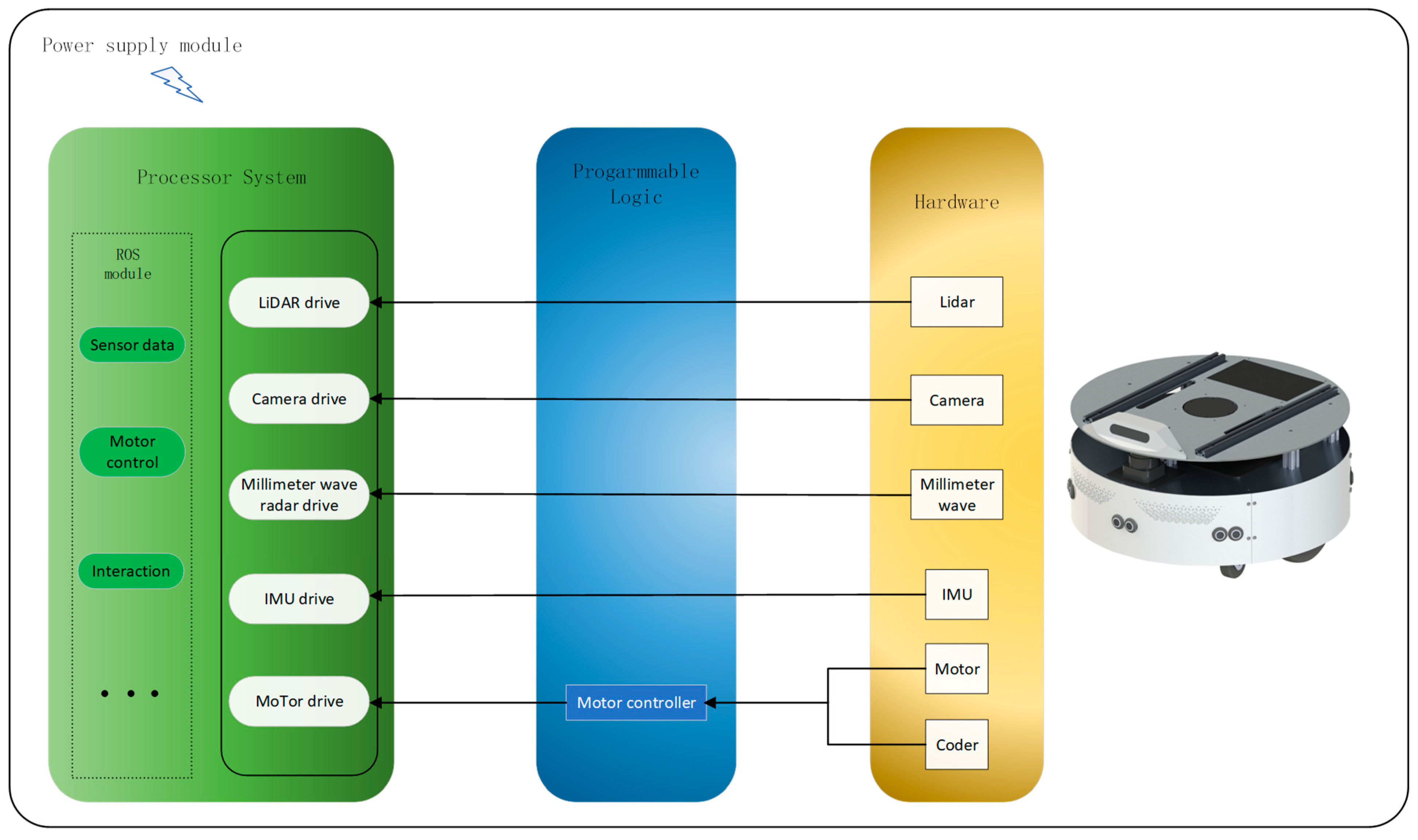

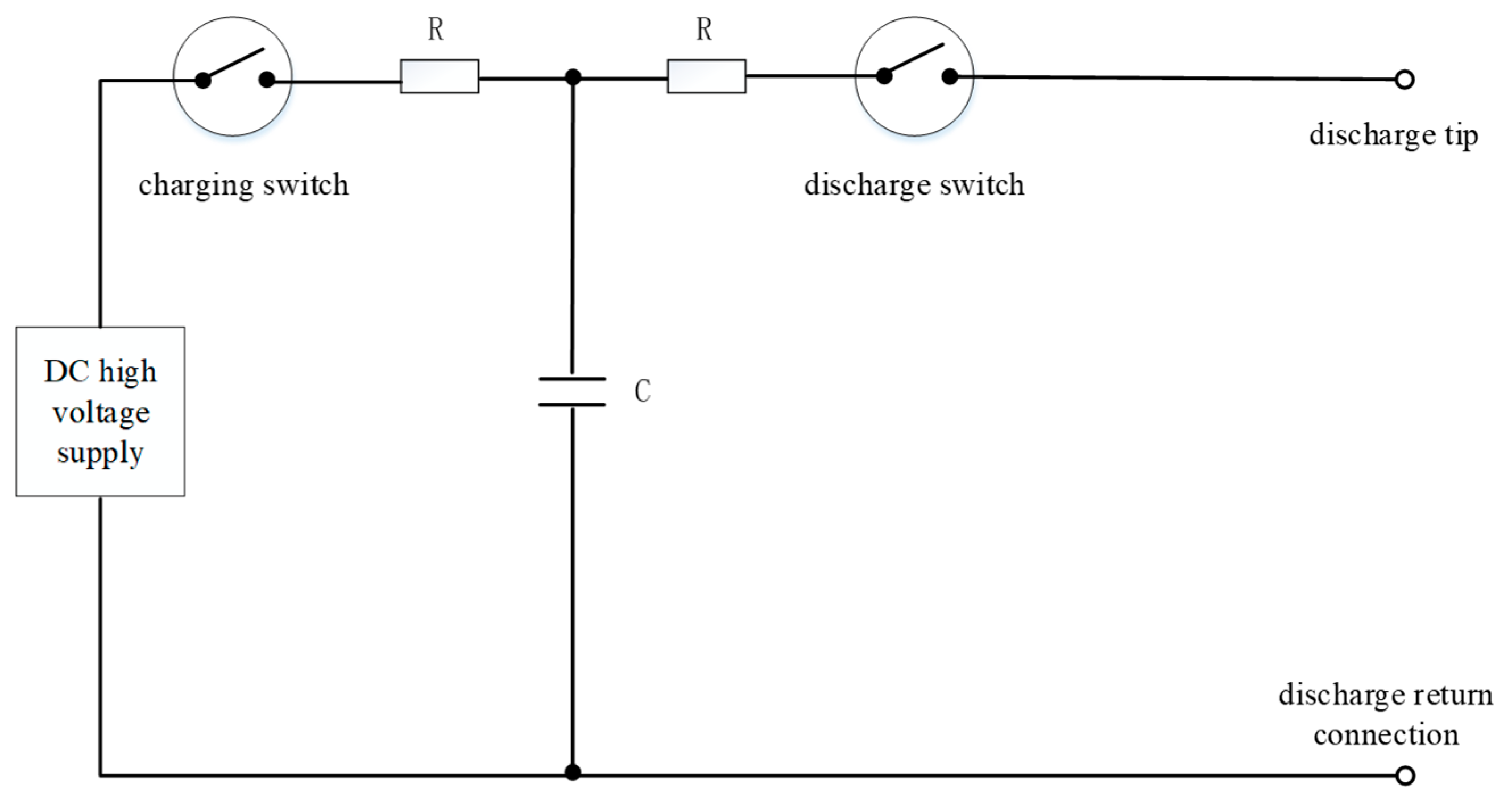

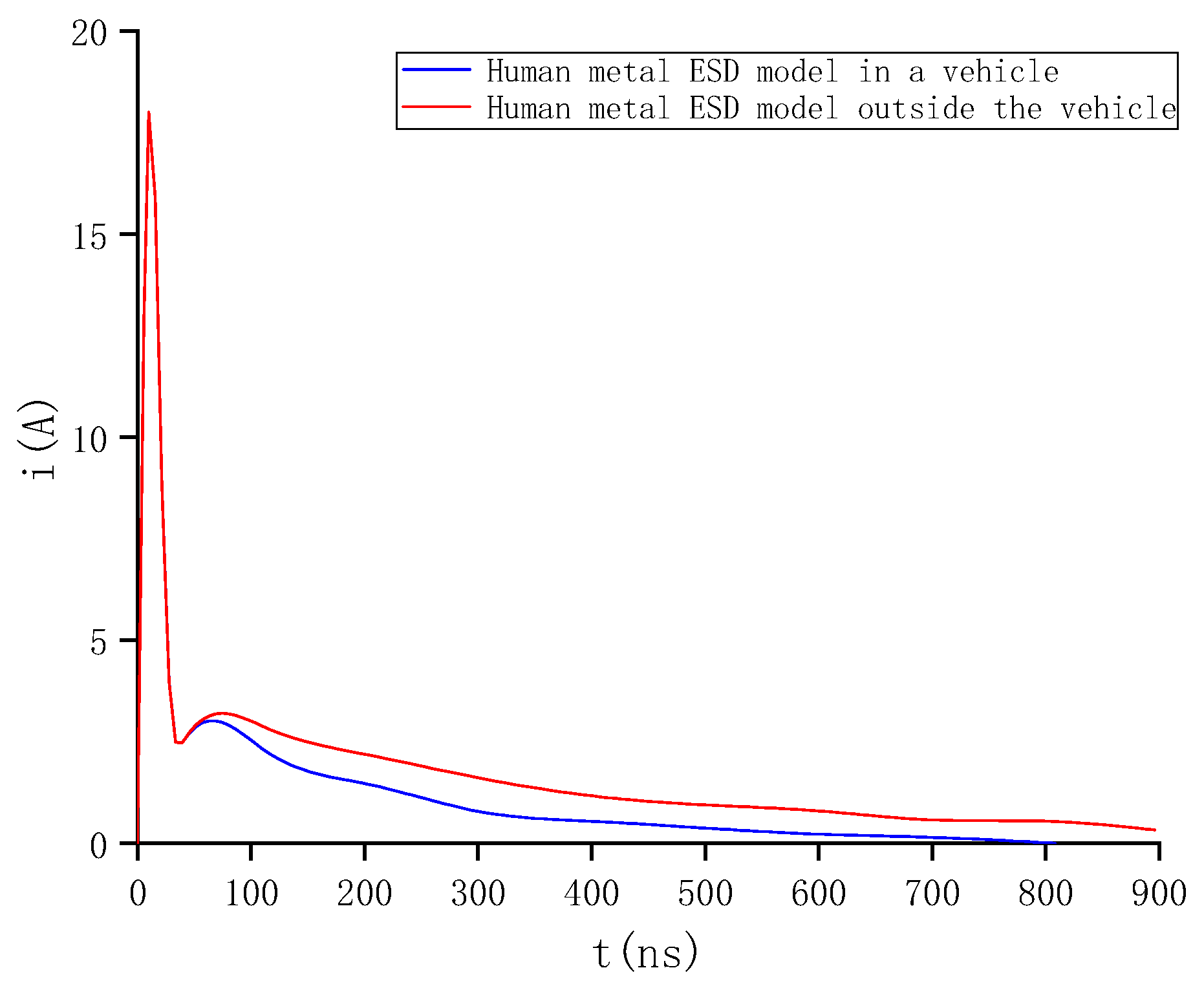
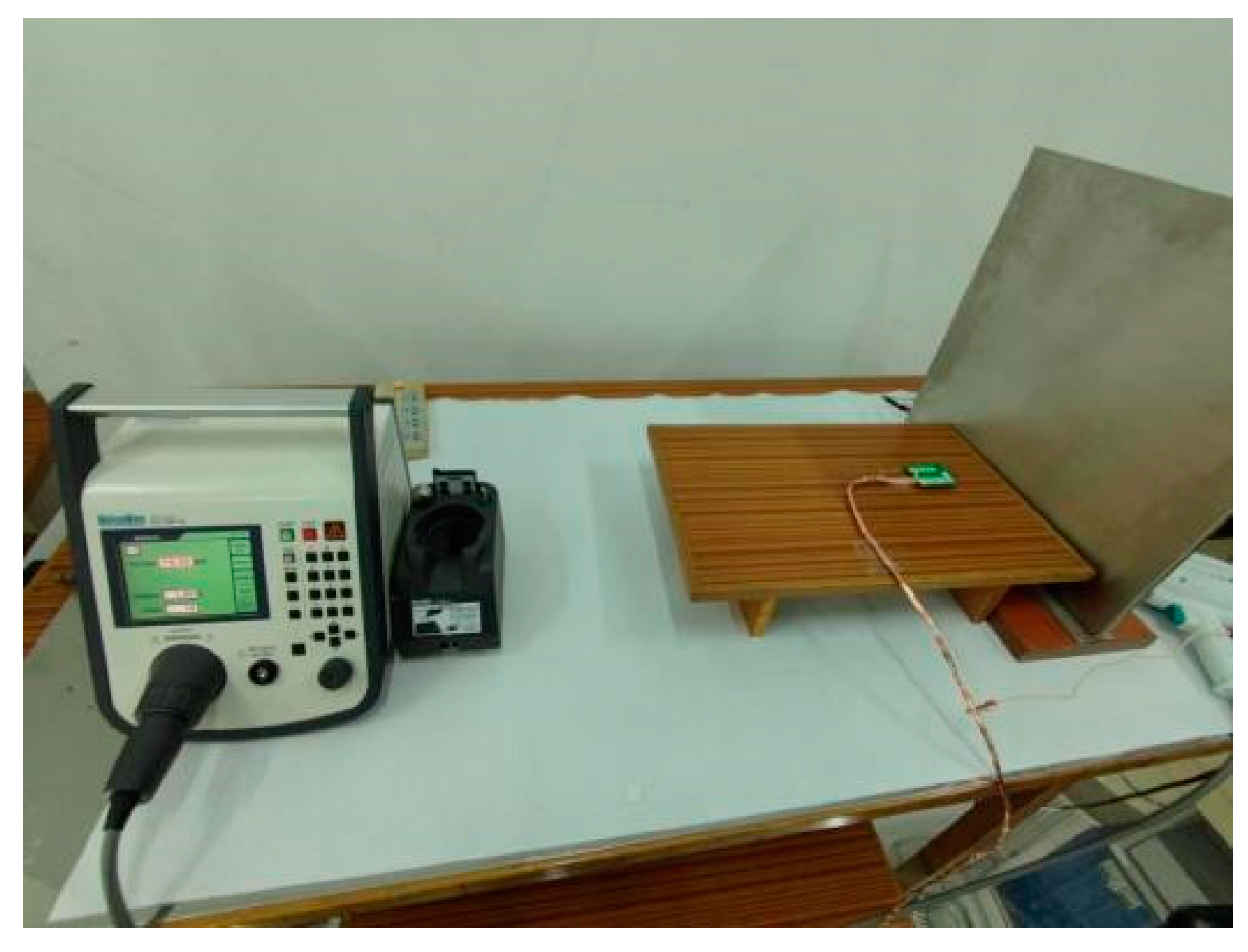
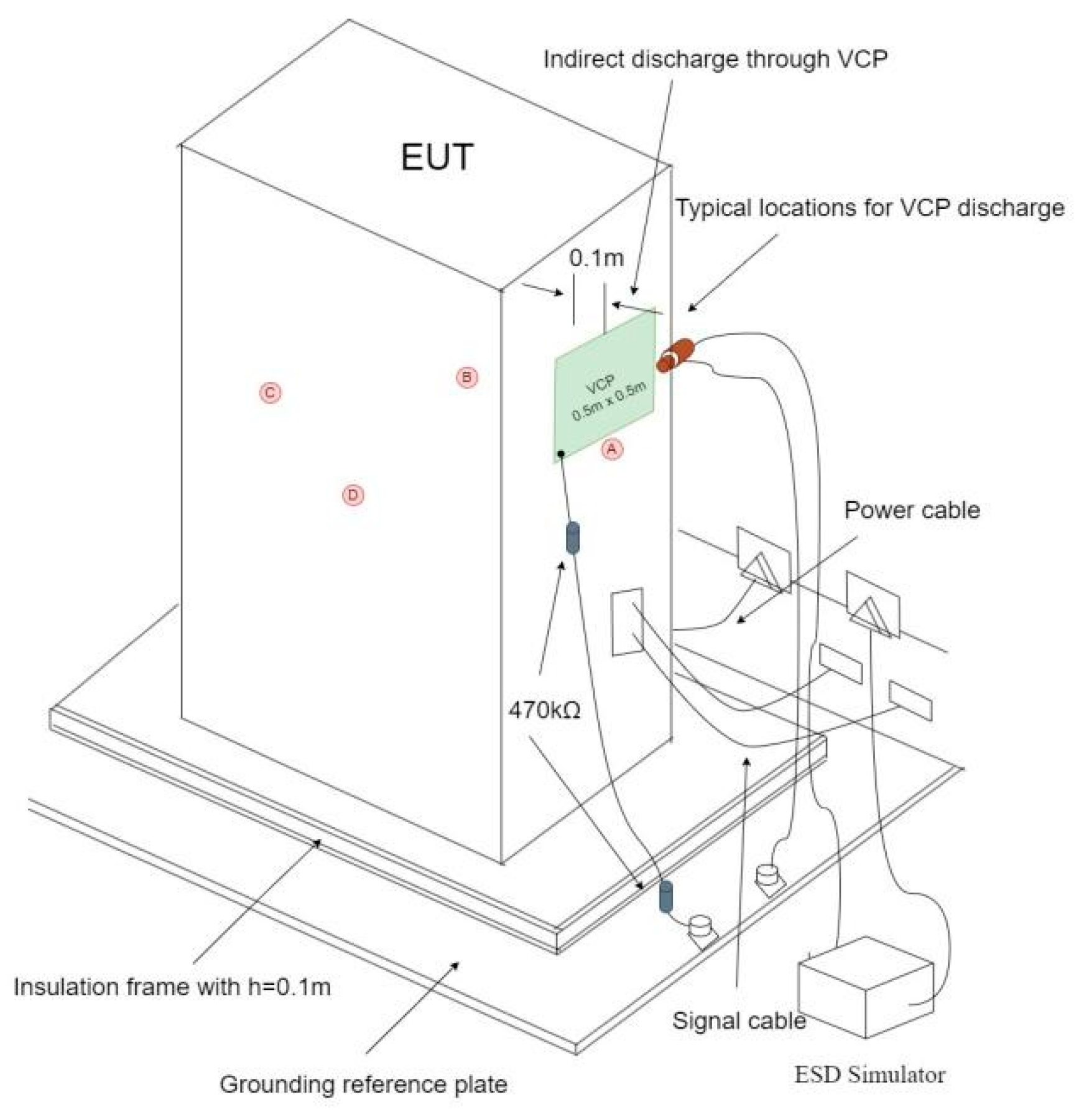
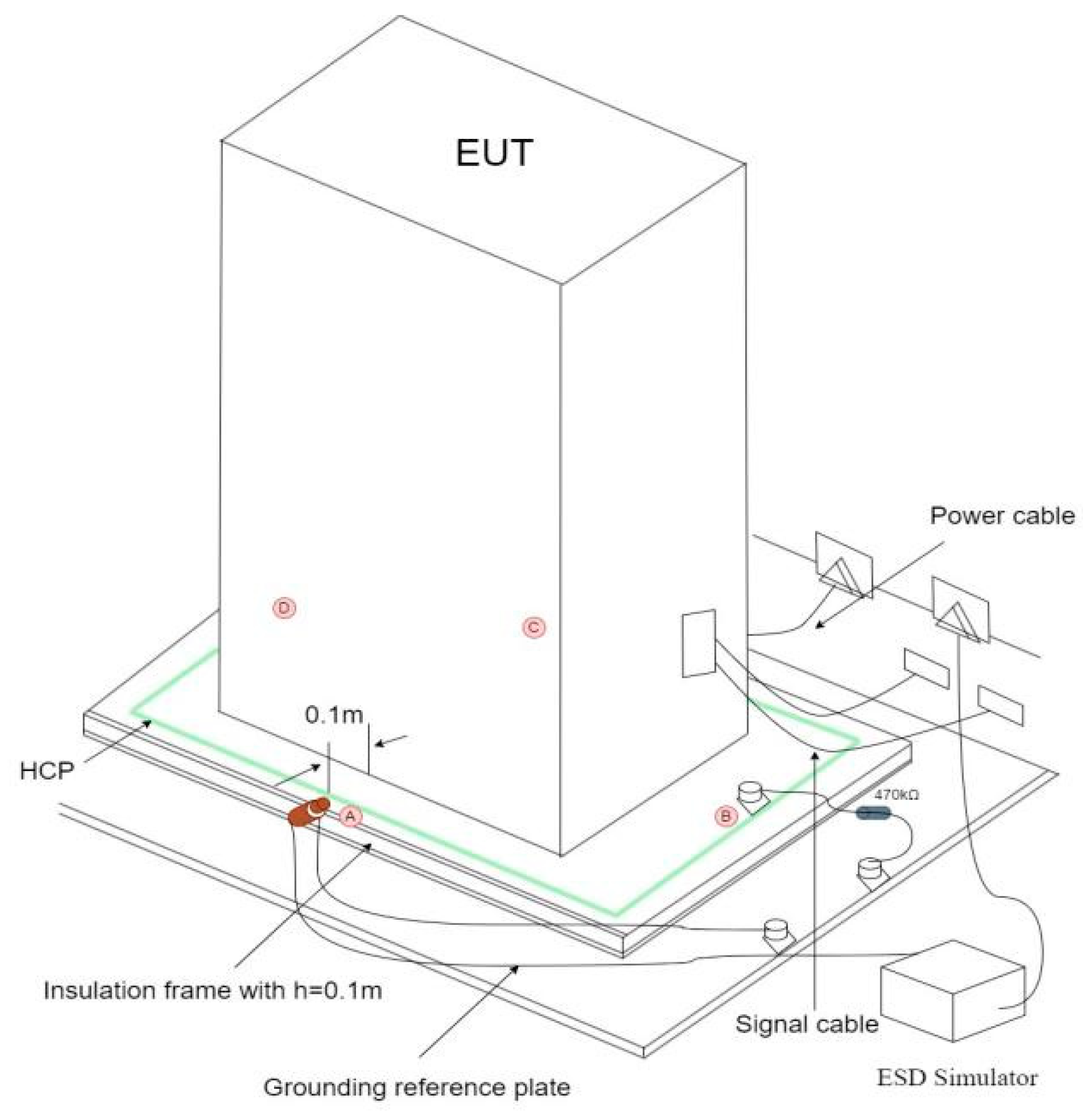
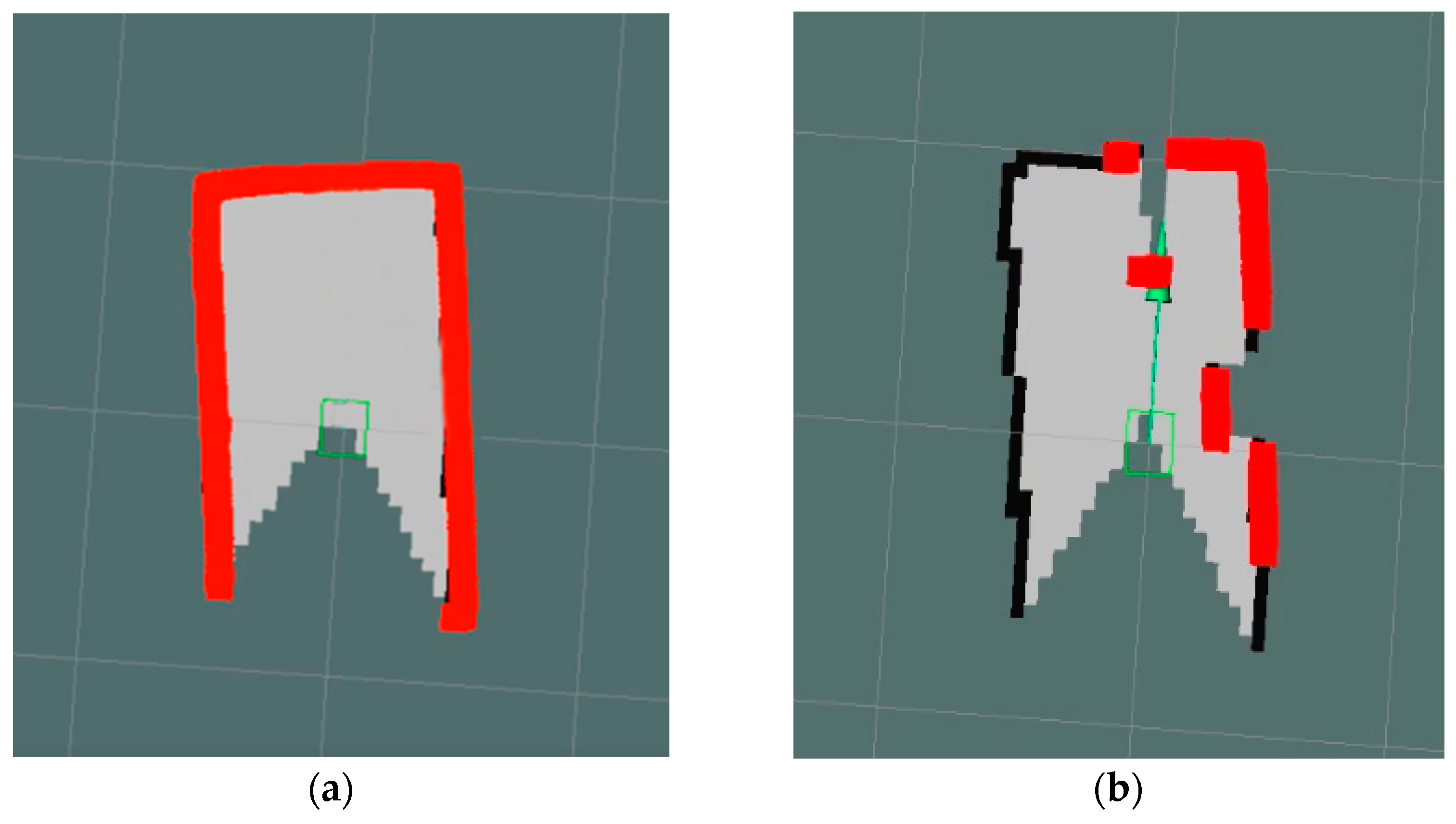
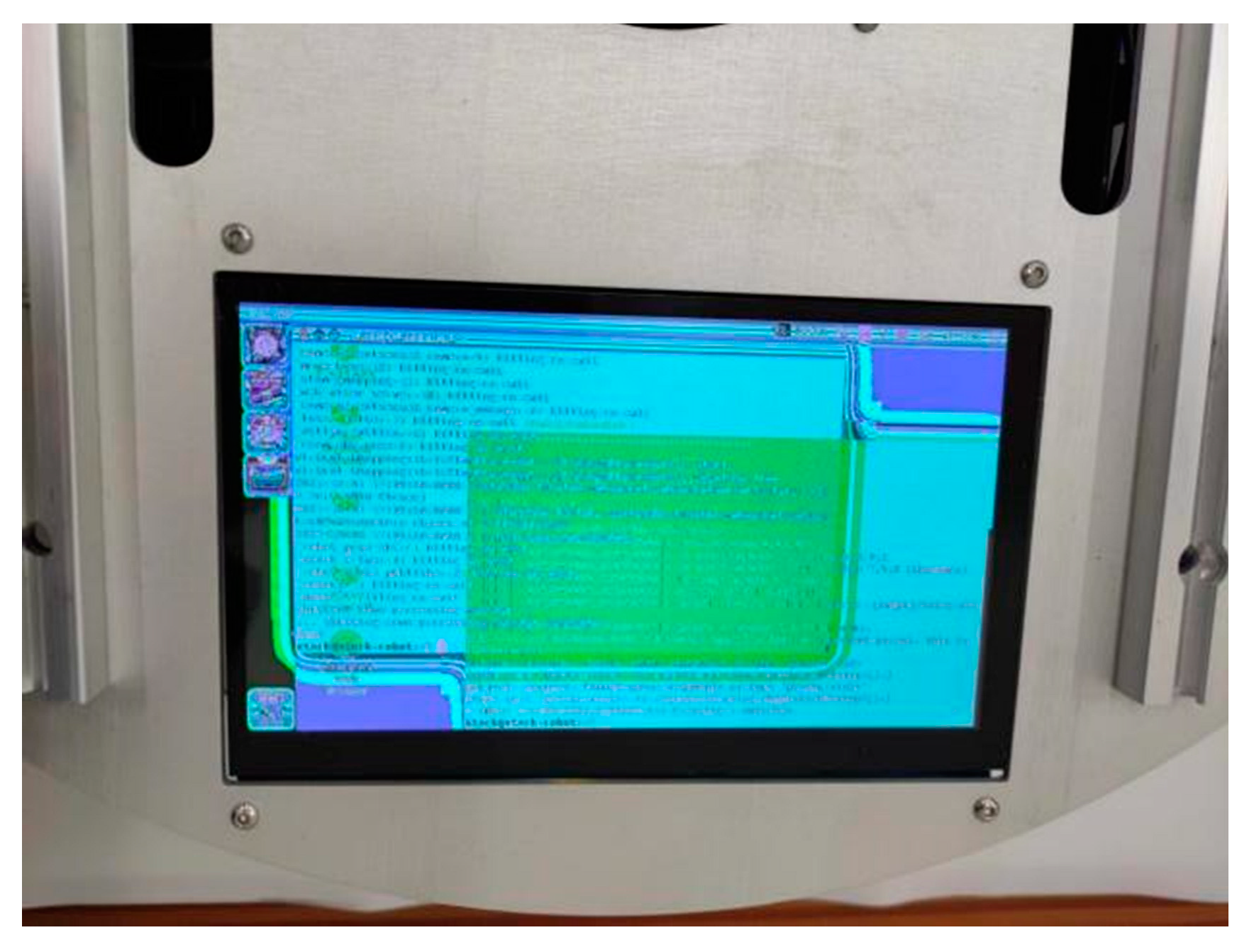
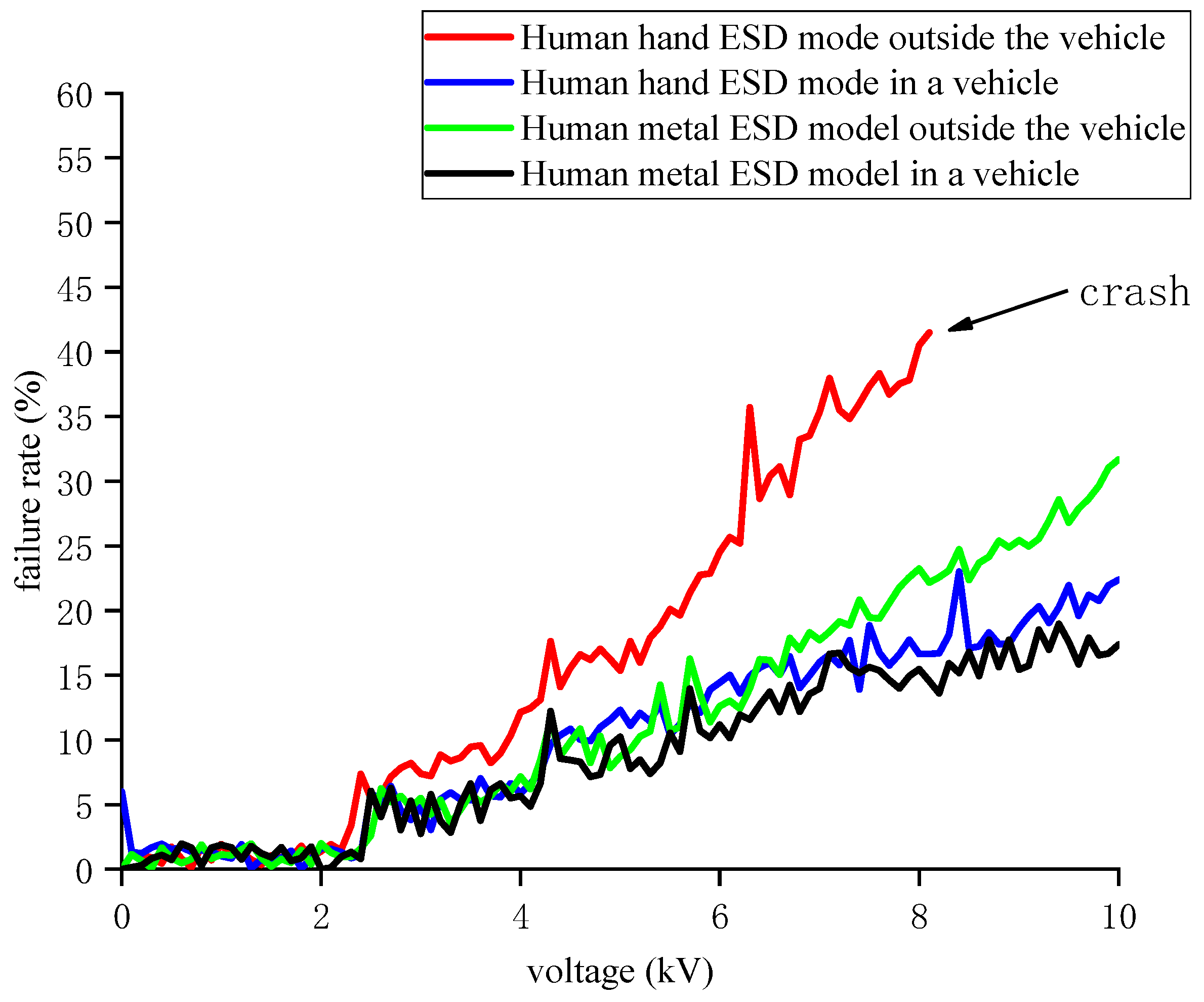
| Sensor | XT-25C Commercial LiDAR | ARS408-21 Millimeter-Wave Radar | RealSence D435 Camera |
|---|---|---|---|
| Test standards | EN 61000-6-4 IEC61000-4-6 21 CFR1040.10 | IEC61000-4-2 IEC61000-4-4 EN 301 489-1 CISPR 11 | ISO 11452-2 IEC61000-4-2 FCC Part 15B |
| Discharge Model | Energy Storage Capacitance (PF) | Discharge Resistance (Ω) |
|---|---|---|
| Human metal ESD model outside the vehicle | 150 | 2000 |
| Human metal ESD model in a vehicle | 330 | 2000 |
| Human hand ESD mode outside the vehicle | 150 | 330 |
| Human hand ESD mode in a vehicle | 330 | 330 |
| Discharge Mode | Human Hand ESD Mode Outside the Vehicle (kV) | Human Hand ESD Mode in a Vehicle (kV) | Human Metal ESD Model in a Vehicle (kV) | Human Metal ESD Model Outside the Vehicle (kV) |
|---|---|---|---|---|
| Vertical coupling plate | 6 | 6 | 6 | 8 |
| Horizontal coupling plate | 8 | 8 | 16 | 10 |
| Contact discharge | 4 | 10 | 6 | 5 |
| Air discharge | 5 | 12 | 3 | 5 |
| Discharge Voltage | Discharge Model | Discharge Mode | Sensing the Working State of the Module |
|---|---|---|---|
| 1 kV | Four discharge models | Four discharge modes | Normal |
| 2 kV | Four discharge models | Four discharge modes | Normal |
| 3 kV | Manikin outside the car | Air discharge | LiDAR data is temporarily missing |
| 4 kV | Human hand ESD mode outside the vehicle, Human metal ESD model in a vehicle, Human metal ESD model outside the vehicle | Air discharge, contact discharge, vertical coupling plate | LiDAR data is temporarily missing; millimeter-wave radar crashes, and it works normally after restart |
| 5 kV | Human hand ESD mode outside the vehicle | Contact discharge | LiDAR data is temporarily missing |
| 6 kV | Human hand ESD mode outside the vehicle | Contact discharge, horizontal coupling plate | The LiDAR data are seriously missing, and the obstacle location is significantly offset |
| 7 kV | Human metal ESD model outside the vehicle | Contact discharge | The LiDAR data are seriously missing, and the obstacle location is significantly offset |
| 8 kV | Human hand ESD mode outside the vehicle | Horizontal coupling plate | The LiDAR crashed and returned to normal after restart |
| Discharge Mode | Positive Electrode (kV) | Negative Pole (kV) |
|---|---|---|
| Vertical coupling plate | 5 | −4 |
| Horizontal coupling plate | 6 | −10 |
| Contact discharge | 6 | −4 |
| Air discharge | 4 | −3 |
Disclaimer/Publisher’s Note: The statements, opinions and data contained in all publications are solely those of the individual author(s) and contributor(s) and not of MDPI and/or the editor(s). MDPI and/or the editor(s) disclaim responsibility for any injury to people or property resulting from any ideas, methods, instructions or products referred to in the content. |
© 2023 by the authors. Licensee MDPI, Basel, Switzerland. This article is an open access article distributed under the terms and conditions of the Creative Commons Attribution (CC BY) license (https://creativecommons.org/licenses/by/4.0/).
Share and Cite
Zhang, Y.; Shen, Y.; Ma, G.; Man, M.; Liu, S. Analysis of Electrostatic Discharge Interference Effects on Small Unmanned Vehicle Handling Systems. Electronics 2023, 12, 1640. https://doi.org/10.3390/electronics12071640
Zhang Y, Shen Y, Ma G, Man M, Liu S. Analysis of Electrostatic Discharge Interference Effects on Small Unmanned Vehicle Handling Systems. Electronics. 2023; 12(7):1640. https://doi.org/10.3390/electronics12071640
Chicago/Turabian StyleZhang, Yongqiang, Yuejian Shen, Guilei Ma, Menghua Man, and Shanghe Liu. 2023. "Analysis of Electrostatic Discharge Interference Effects on Small Unmanned Vehicle Handling Systems" Electronics 12, no. 7: 1640. https://doi.org/10.3390/electronics12071640





